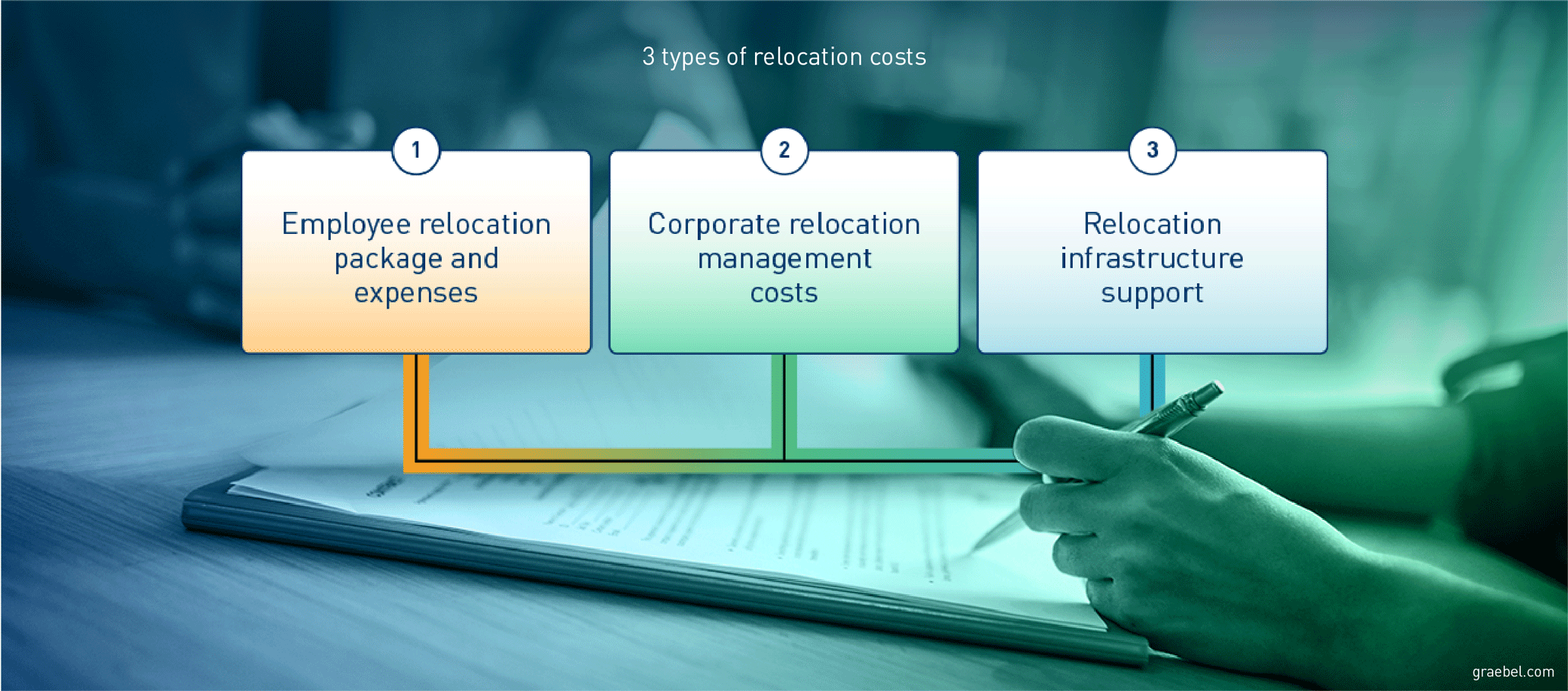Hidden Relocation Costs: Why Outsourcing is a Smarter Move

Do you know the true cost of relocating your employees?
The answer might seem simple on the surface. But when you really dig in, there are a lot of relocation costs that aren’t so obvious.
That’s why it’s essential to get a fresh point of view. You might be surprised to learn you’re spending more than you should.
What is the actual cost of relocating employees?
Whenever your company moves an employee, the investment is significant. But understanding the actual relocation costs can often be a bit tricky. While the most visible expense is the physical move, even this isn’t a simple calculation. Often the cost of transferring employees from one destination to the next depends on these factors:
- Relocation volume
- Competition for talent
- Geographic location
- Employee role
- Relocation package breadth (lump sum, core-flex, VIP, etc.)
There are also “hidden” expenses that add to the cost of relocating your employees. While these expenses are easy to overlook, they’re critical for getting an accurate picture of your workforce relocation spend.
Additionally, there are costs your organization incurs when it fails to provide an exceptional relocation experience. Unsuccessful transfers can result in thousands of dollars in lost investment and revenue. That’s why it’s so important to get this right.
What do relocation costs include?
While there are likely many ways to categorize your relocation costs, we find it helpful to organize them into three main groups:
- Employee relocation package and expenses
- Corporate relocation management costs
- Relocation infrastructure support

1. Employee relocation package and expenses
This category covers your employee’s moving and settling-in costs. Our data shows an executive relocation package value typically ranges between $150,000 to $250,000 USD, while a new graduate may only receive a $5,000 to $7,000 USD package. However, the amounts can increase or decrease depending on the factors mentioned earlier.
Specifically, the employee relocation package and associated expenses include the following relocation costs:
-
Travel
Transportation costs for moving mobile employees and their family to the new destination, return trips to the home location and expenses while in transit, like food and lodging
-
Housing and moving expenses
Real estate costs associated with selling the mobile employee’s home or breaking a lease, providing transferees and their family with temporary accommodations, buying or leasing long-term housing and packing and shipping of household goods
-
Tax gross up
Increasing the mobile employee’s salary, bonus and other taxable income so the employee doesn’t have to pay the tax (e.g. If the company grants an employee a bonus of $500,000, the tax gross up means that the individual will receive a check for the full amount after taxes)
-
Support services
Costs involved in helping mobile employees find an appropriate school for their children, language training expenses and any fees associated with destination orientation and support
2. Corporate relocation management costs
This category covers all the human capital and administrative expenses involved in running your workforce mobility program. Specifically, corporate relocation management costs include:
-
Internal workforce mobility professionals
In-house staffing to support the workforce mobility program as well as costs associated with strategy development, stakeholder communication, vendor management and employee awareness and education
-
Relocation Management Company (RMC)
Third-party costs for supporting your internal workforce mobility team and your mobile employees. Services can include strategy development, program management and administration, as well as reporting
3. Relocation infrastructure support
This category covers all the operating expenses involved in providing corporate relocation services. When you work with an RMC, these costs are included in the service fee. Specifically, relocation infrastructure support expenses include:
-
Supply chain management
Finding, coaching, vetting and auditing vendors on a regular basis
-
Financial management
Managing the timely auditing and payment of vendors around the globe, reimbursing transferees for expenses and tracking and reporting program costs
-
Technical management
Developing and managing the relocation software as well as the technical infrastructure required to coordinate relocation services, report on them, and identify gaps, trends and
opportunities for improvement
5 reasons outsourcing relocation improves cost-efficiency
It’s easy to assume an in-house model is a more financially viable option for relocating your employees. But once you examine both the hard and soft costs, outsourcing relocation is less expensive than managing relocation internally. In fact, organizations that relocate employees regularly will get more value from the same workforce mobility budget when partnering with a relocation management company (RMC).
Here are five reasons why outsourcing relocation is a smarter move:
1. Optimizes your employee relocation investment
Moving your employees requires a significant investment, so you need it to pay off. Otherwise, it could cost your organization a lot more in wasted time, budget and resources. For this reason, it’s important to remember relocation isn’t about finding the cheapest way to get your employees to their new destination. It’s about maximizing the success of the initiative.
When a move takes a long time, employee satisfaction drops. When there are claims due to lost or broken items, employee satisfaction goes down. When employees feel stressed or lack clarity and communication, satisfaction and productivity decrease. And when the family is unhappy, satisfaction dips so low the relocation can fail.
An RMC minimizes challenges that will threaten relocation success. It also maximizes the opportunity to deliver an exceptional employee relocation experience, one that keeps employees happy, productive, and loyal. By working with dedicated relocation specialists, you increase the likelihood of a positive outcome. These consultants are experts at anticipating issues, proactively addressing concerns and communicating in a way that doesn’t add to your employees’ stress.
The best part is the cost. An RMC’s services only amount to two to five percent of an organization’s total relocation spend. So, this small investment is well worth it, particularly when you can retain high-performing employees who drive increased revenue for your organization.
2. Eliminates the need to build an expensive relocation infrastructure
Very few companies have a workforce mobility program that is simple enough to manage in-house. Simultaneously moving multiple people to multiple locations just demands diverse knowledge and expertise. There are too many logistics to manage and too many changing laws and regulations that require constant attention. In fact, this complexity often makes it cost-prohibitive to build an in-house team.
Outsourcing to a credible relocation management company offers several cost benefits:
-
Reduces unnecessary headcount
Your organization can maintain a core strategic mobility team to manage relocation instead of hiring excess staff to handle unique relocation scenarios.
-
Decreases relocation infrastructure costs
Your organization can keep the focus on achieving its revenue goals. You don’t need to spend unnecessary time and money to implement and maintain a highly complex
relocation infrastructure to support domestic and international moves. -
Eliminates administrative overhead
Your organization can concentrate on improving the employee relocation experience to increase bottom-line results. You don’t need to get bogged down in time-consuming
administrative tactics, such as auditing thousands of vendor invoices, providing timely payments and keeping up with all the immigration and tax laws to process them in a compliant way.
3. Provides relocation cost benefits from supplier economies of scale
Finding and contracting the right partners to support workforce mobility is an expensive undertaking in itself. But even if your organization curates its own supplier network, obtaining the best rates is unlikely without significant volume.
In contrast, a relocation management company (RMC) can provide your organization with access to top-tier suppliers while increasing negotiating power. It uses its total client volume to secure competitive rates that would be impossible to achieve independently. Additionally, an RMC’s dedication to supplier management ensures providers continue to meet key performance indicators (KPIs) in the service level agreement (SLA), so they drive ongoing value.
When suppliers don’t meet compliance standards, this also increases your costs and negatively impacts your employee’s relocation experience. It’s not feasible for an in-house team to dedicate the resources required to monitor and maintain supplier compliance. But an RMC already has the infrastructure in place to audit suppliers regularly at scale. This ensures your organization doesn’t have to deal with additional expenses that result from non-compliance.
4. Reduces inefficiencies that drive up incremental relocation spend
When it comes to corporate relocation, speed matters. Any delays or inaction that prevent mobile employees from getting to their destination drive up relocation spend.
Partnering with a relocation management company (RMC) allows your organization to benefit from efficient processes and expertise. This means you can avoid scenarios that end up costing your organization much more in the long run, including:
-
Delays in relocating a team to change a factory production line
Every day the team (or a member of the team) is delayed or disrupted, that production line is not operating. This results in lost revenue for your company. An RMC keeps everything on schedule to prevent this from happening.
-
Postponing a trip to get a better deal
Booking an airline ticket two weeks in advance might lower the ticket price. But this means the employee won’t reach the destination for several more weeks. Delaying a flight to save a few hundred dollars will cost the company more in lost productivity. An RMC recognizes these common pitfalls and focuses on making the best financial decisions for your organization.
-
Paying too much for temporary housing
Temporary accommodations give mobile employees time to select a more permanent residence. But the longer that process takes, the more expensive this situation can be. An RMC keeps employees motivated and moving forward with a long-term home search to avoid housing costs that exceed your budget.
5. Uncovers opportunities to stretch your relocation budget through cost analysis
Workforce mobility teams are often under pressure to cut costs. But cutting the wrong costs can have a detrimental impact on relocation program success. That’s where a relocation management company (RMC) can provide significant value.
A credible RMC will help you maximize your relocation budget without detracting from your employee’s experience. Instead of decreasing relocation assistance benefits or reducing stipends, an RMC takes a different approach. First, it examines the entire workforce mobility program. Then, it uncovers ways to decrease or eliminate pass-through costs that make up 95% to 97% of your organization’s relocation spend.
For example, temporary housing is a typical corporate relocation benefit provided to transferees. But it’s also one that can cost a lot more than it should. An RMC can analyze supply and demand algorithms to determine how to optimize your spend. The solution may be to book a higher-tier room for an extended stay because it’s less costly than a regular room for the same period.
In the end, the goal is to work smarter to find cost-cutting measures that elevate the mobile employee experience rather than detract from it. By partnering with an RMC, you can take advantage of its knowledge and expertise to reduce relocation expenses in the right way. This approach also boosts your internal workforce mobility team’s experience because they can maintain employee satisfaction while meeting corporate budgetary requirements.
Sign up for our employee relocation cost-savings workshop
Our Talent Mobility Cost Savings Tool is a step-by-step, data-driven exercise to identify alternative approaches to many aspects of your Mobility program.